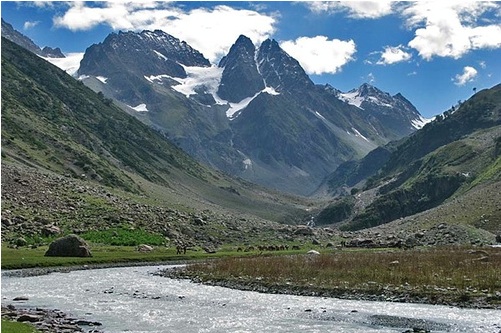
As I looked at the Himalaya Mountains, from my window, on a flight from New Delhi to Kashmir last week, I realized that something was missing. Snow. The mountains usually snowcapped by December were bare. My friends in Kashmir had told me that this was an abnormally warm winter and there was no snow, but somehow I just did not realize the magnitude of the situation. I was not the only one.
There were four young men from Switzerland on the plane as well. Armed with their snowboards and skiis, they were headed to Gulmarg, a ski-resort two hours north of Srinigar, the capital. Their excitement to hit the powder-covered slopes was quickly squelched as they looked at the brown mountain-tops in the distance. None of us wanted to believe what we were seeing, the Himalaya in the middle of winter with no snow.
This was my third trip to Kashmir, my second trip during the winter. I'd spent three months writing about climate change in the region, but was not prepared for what I found upon my return. Instead of seeing snow covered rooftops, I saw rose bushes blooming in the middle of January.
In an effort to better understand what was going on, I consulted Dr. Shakil Romshoo, a professor in the Department of Geology and Geophysics at the University of Kashmir.
"To date this is the winter with the least amount of snow," he said. "If you look at the statistics, there is a trend the past ten years. Each winter the snow gets less and the temperatures increase. Now there is no snow in December and very little snow in January and February."
Romshoo believes the warmer winters will have a devastating affect on tourism in places like Gulmarg that depend on heavy snowfall. "There used to be three to four feet of snow in Gulmarg, now there is only five to six inches." He says the changes in temperature will also be a huge problem for farmers.
"Farmers rely on the heavy snow's in winter to water their crops during the spring," he said. Basically, a winter with out snow means that farmers will automatically be facing extremely dry conditions in the spring." Usmaan Amad, the director of Mercy Corps, an international research organization agreed.
"In the past farmers have relied on snow-melt to irrigate their crops in the spring," said Usmaan, a Kashmiri American who moved to Srinigar two years ago to help set up a climate mitigation and adaptation program. "It is hard to tell if this winter is just a fluke or if it is really related to climate change. Either way, many of the farmers we work with may have to dig wells for the first time because they can no longer rely on irrigation from nearby rivers."
He said the warmer winter weather is also a problem for farmers. "If crops bloom early and then there is a freeze or a hail storm, farmers will loose their entire crop."
Though Usmaan hopes he can make some headway with the work he is doing with farmers, he knows there is still a long way to go.
"It is hard to convince farmers they should change the farming methods they have been using for generations," he said. "They know they weather is changing but they don't know what to do about it. Many farmers just say 'God will take care of it' and do nothing."
As farmers and skiers in Kashmir look to the sky for snow, Dr. Romshoo believes that if the snow does come this year it will be to late.
"Even if the snows comes now, the ground is too warm for it to really stick. We have always relied on the snows in December and January as a base layer. But this winter the snow just didn't come."





